Top News
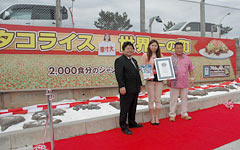
April 11, 2012 Ryukyu Shimpo
On April 6, a huge sign stating, “The town with the biggest Taco Rice in the world” was placed in Kin, with mayor Tsuyoshi Gibu declaring the town to be the “town of taco rice.” Taco rice was thought up in Parlor Senri in the restaurant area called Shinkaichi in front of the U.S. Marine Corps Base Camp Hansen in 1984 and since then has spread all over Okinawa and Japan.
In 2010, the Kin Society of Commerce and Industry made the world biggest dish of taco rice, which is officially recognized in the Guinness Book of World Records. The sign is as big as the Guinness World Record dish of 180 centimeters wide and 12 meters long.
At the unveiling ceremony, Morimitsu Kokuba, the chairperson of the society said, “This sign is going to be the symbol of the town, which is known as the town of taco rice both in reality and in name.”
Mayor Gibu commented, “Taco rice is the result of a blend of different food cultures. We want to use this local resource to good effect to attract people to our town.”
(English translation by T&CT, Shinako Oyakawa and Mark Ealey)
Go to Japanese
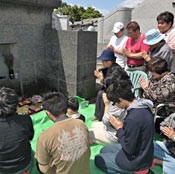
April 9, 2012 Ryukyu Shimpo
April 8 was the first Sunday of the Shimi Festival season, when the people of Okinawa celebrate ancestral spirits on the lunar calendar. The Shikina Cemetery in Naha was crowded with families offering foods, including tempura and rice cakes. Participants prayed in front of family tombs for their family members’ health and happiness.
According to the Okinawa Meteorological Observatory, the temperature in Naha that day was 22 degrees Celsius. Due to the fine, warm weather the large number of families assembled around the tombs led to traffic congestion. Seventy-two year-old Mitsuko Inafuku, who belongs to Uezu monchu or a relatives’ group, said, “It is difficult to get together because of the traffic and the fact that each of us have so many things to do, but I am happy to see my children and grandchildren here.” Seventeen year-old Taiki Inafuku commented, “I would like to let my ancestors know that my younger brother has passed the entrance exam for high school.”
(English translation by T&CT, Shinako Oyakawa and Mark Ealey)
Go to Japanese
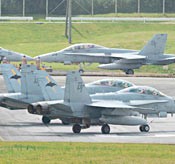
April 11, 2012 Ryukyu Shimpo
In the morning on April 10, a number of Boeing F/A-18 Hornet aircraft, the type that crashed in Virginia on April 6, flew to U.S. Marine Corps Air Station Futenma in Ginowan. Among the 12 aircraft that flew to the base, four are based at Iwakuni Air Station (Iwakuni, Yamaguchi Prefecture) and the rest at Marine Corps Air Station Miramar in California. Eight of the aircraft are the same type as the one that crashed in Virginia.
Twelve aircraft landed on the south side of a runway at 10:34am before repeating takeoffs and landings until around 1:00pm. When interviewed by the Ryukyu Shimpo, a representative of the U.S. Marine Corps said that it was a part of routine training exercise. We place safety as the top priority.
The elementary schools around the base carried out enrollment ceremonies on the same day and on this basis the Ginowan Municipal Office requested in writing through the Okinawa Defense Bureau that the U.S. military refrain from flying their aircraft at that time. The Second Futenma Elementary School and Takushi Elementary School of Urasoe were forced to halt their ceremonies due to the level of the aircraft noise.
The F/A-18 Hornet mentioned above crashed into an apartment building in a residential area in Virginia shortly after takeoff. The U.S. Navy stated that the aircraft suffered an engine-related mechanical failure, but the cause of the accident is still not clear.
On March 30, the Okinawa Defense Bureau requested that the U.S. side take the ceremonies into consideration. Ginowan mayor Atsushi Sakima said, “The flight of fighter aircraft to the base itself could increase the danger to the surrounding area. In the context of noise issues that exist, it was regrettable that the aircraft flew to the base on the very day when enrollment ceremonies were held. I want to lodge a protest about this.”
(English translation by T&CT, Mark Ealey)
Go to Japanese
April 4, 2012 Ryukyu Shimpo
Yoshimoto Kogyo, a well known Japanese entertainment company has suggested to the Japanese government and the Okinawa Prefectural Government (OPG) that land previously occupied by U.S. bases should be used to promote Okinawa to the world as a creative hub for the entertainment industry. The company plans to enhance the environment for the creation of content such as games and animation and to attract creators from both home and abroad. It also hopes to establish an entertainment school to develop skills for films and plays, and a shopping area. The proposal also factors in the use of land after the return of U.S. military bases.
It is calculated that the total area for the project would be over 17 hectares and that the construction cost would be around two billion yen. A spokesperson for the OPG commented, “The Okinawa International Movie Festival is an example of how we attach great importance on the entertainment industry and the fostering of human resources in Okinawa. This project does not hinge on plans to make use of land after the possible closure of U.S. bases. We would like to support the concept.” As the first stage in the project, the company wants to build a facility to develop human resources. The person in charge stressed that the idea is not premised on the return of U.S. military bases, saying, “Okinawa has a very unique culture and entertainment. We would like to develop this prefecture as art-oriented islands. We have a long-term vision, and hope to carry it out step by step.”
In terms of specific plans, the company has provided the following goals:
1. A place where creators work.
2. The habitat where thousands of people can live.
3. A school where people can study films and plays.
4. A shopping area that has an outlet mall and a small-scale casino.
(English translation by T&CT, Lima Tokumori and Mark Ealey)
Go to Japanese
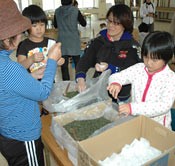
April 4, 2012 Ryukyu Shimpo
On April 1, at Oku in Kunigami, tea picking and bagging was held for a project to present the first-picked tea, the earliest tea picking in Japan, to areas stricken by the Great East Japan Earthquake as spring gifts. The Fan Club of the Local Community-based Cooperative Stores in Okinawa organized the project and 25 people participated from around Okinawa hoping to support the affected areas.
The project made use of donations of about 200000 yen collected by members. Cooperating with Oku Ward, the Oku Cooperative Store and the Oku Tea Industry Association the club prepared 26-kilograms of first-pick tea. People bagged 50 grams of tea in each pack by hand, and 600 packs in total. The tea will be sent to an evacuation center in Saitama where residents from Futaba in Fukushima have been evacuated because of the situation at the Tokyo Electric Power Company Fukushima Daiichi Nuclear Power Units Five and Six.
Unlike the Oku-midori, the first-pick tea that the cooperative store sells in 100-gram packs, the club created their original product blending two types of leaf and attaching a label with the message “Support for disaster areas” to the package.

The first-pick tea, the Oku-midori, was sent to the affected areas.
Professor of the Okinawa University Yoshihiko Miyagi who has carried out research related to cooperative stores and has worked with the club, said, “This project aims to encourage disaster victims, generate income for the cooperative stores, and to make Oku better known. It’s designed to bring benefits to all three parties.” He hopes to support the afflicted areas and to work to help revitalize the cooperative stores. Isamu Makishi, the president of the club encourages people to drop by the cooperative stores.
This first-pick tea, the earliest-picked in Japan, will be available for shipment by the middle of April, and if the number of supporters grows the club will run a second and third round of projects. There is a donation system through which supporters can buy tea for the devastated areas and for their own use from 1000 yen a set.
For further information, please refer to the official blog of the Fan Club of Local Community-based Cooperative Stores in Okinawa.
Website: http://kyoudoubaiten.ti-da.net/
(English translation by T&CT, Lima Tokumori and Mark Ealey)
Go to Japanese
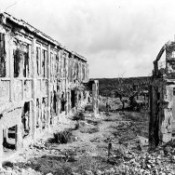
April 9, 2012 Tomoya Kohatsu of the Ryukyu Shimpo
On April 8, the Ryukyu America Historical Research Society acquired 151 photographs of scenes in Okinawa during the period from directly after World War II to the 1960s. The collection includes photographs of people and scenery all over Okinawa from its northern area, including Ogimi to the southern area, including Itoman. A sequence of photographs gives us a view of the dilapidated buildings of the first Okinawa Prefectural Junior High School, a savvy dealer selling an Okinawan farmer’s kuba hat to a U.S. soldier, and scenery of Itoman, which in those days was then crowded with houses with tiled roofs that had somehow survived having been exposed to fierce naval bombardment.
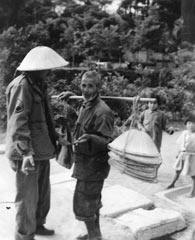
A man selling a kuba hat to a U.S. soldier.
These photographs are scheduled to be displayed at an exhibition titled
Mayaga, Tayaga, Nuyaga (Where, Who and What?) to mark the 40th anniversary of Okinawa’s reversion to Japanese sovereignty. The exhibition is hosted by Kitanakagusuku Village and co-hosted by the Ryukyu Shimpo, and will be held at the Kitanakagusuku Village Central Community Center from May 12 to 15.
The photographs belong to Donn Cuson who was stationed in Okinawa as a U.S. Army soldier in the 1960s and currently resides in Arizona. Cuson has many photographs related to Okinawa taken in the period from the end of the war to the time of the reversion to Japan and he has cooperated to provide these photographs.
The exhibition will display about 1000 photographs in addition to those provided by Cuson. It will explain the historical background by displaying photographs of people and geography on a large-screen television.
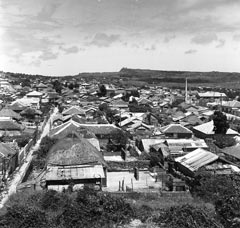
Scenery of then Itoman Town, which was skillfully reconstructed and crowded with many houses during the 1950s despite being exposed to the “Typhoon of Steel” that was the fierce naval bombardment during the Battle of Okinawa. All three photographs were provided by the Ryukyu America Historical Research Society.
Shizuo Kishaba, the society’s director, emphasized the importance of exhibiting the photographs, saying, “These photographs are hugely valuable, but the number of people who can relate the stories behind them is decreasing each year. We would like to use this opportunity to gather historically important materials in the regions.”
Kishaba calls for people who experienced the war and know about the history and culture of Okinawa to volunteer to help explain the photographs at the exhibition. About five people are needed.
For further details, call Ryukyu Shimpo at 098 (865) 5200 on weekdays.
(English translation by T&CT, Mark Ealey)
Go to Japanese
April 2, 2012 Tomoko Oharu of the Ryukyu Shimpo
A survey carried out by the University of the Ryukyus indicates that the noise from the Marine Corps Air Station Futenma exceeded 100 decibels in the classrooms of the Second Futenma Elementary School, which is located next to the air base, Ginowan City, during aircraft take-off and landing. This level of noise is comparable to that heard from the horn of a car being sounded in front of you and could obstruct lessons and cause learning problems in the classroom. The Okinawa Defense Bureau, the Okinawa Prefectural Government and the Municipal Office have previously carried out a fixed-point survey of the points outdoors using WECPNL (Weighted Equivalent Continuous Perceived Noise Level) to assess the level of annoyance caused by aircraft noise around the military bases, but this is the first time that noise in the classrooms has been investigated.
A decibel represents the power or intensity of a sound and in the case of aircraft noise, indicates instantaneous noise level. Takeshi Tokashiki, an associate professor of the University of the Ryukyus (specializing in environmental engineering and noise) and his team have monitored the noise level in the classrooms of the Second Futenma Elementary School since February 24. At 12:45pm on March 20, 66.9 db was recorded in classrooms that had their windows closed to mitigate sound when U.S. military aircraft passed overhead. At 1:07pm of March 23, it was 99.5 db in the classrooms with the windows open and at 1:10pm that same day it was 105.7 db. They carried out their investigation without any children in the classrooms.
In its school environmental health management manual, the Ministry of Education, Culture, Sports, Science and Technology (MEXT) indicates that with the windows closed, noise levels lower than 50 db are desirable, and less than 55 db in classrooms with the windows open. Findings suggest that school children in the Second Futenma Elementary School have been exposed to noise far higher than the desirable level. According to the MEXT manual, an average teacher’s voice is 65 db. The World Health Organization announced a guideline on noise in 1999, stating that in order for the students to be able to hear the lesson the difference between the noise level in the classrooms and the voice level of teacher needs to be at least 15 db.
Tokashiki pointed out, “The children cannot possibly follow the lesson properly when the noise of the airplane drowns out the voice of their teacher. In particular, during the development of their language skills younger children may not understand the lesson.” Harumi Chinen, the principal of the school, who retired on April 1, stated, “At this time of year in Okinawa there are many hot days when you have to open windows. But if we do open the windows, the noise has a negative impact on the children’s learning.” The elementary schools are installed with air conditioners, but schools’ management policy is to use them only during the months from May to November.
In 1996, the governments of Japan and the United States concluded an aircraft noise control measures agreement, in which they confirmed that to the greatest extent possible U.S. airplanes would avoid flying over densely populated areas, including schools and hospitals, but the reality of the situation is that U.S. military aircraft fly low over the school on a daily basis. A spokesperson for the base liaison section of the Ginowan Municipal Office commented, “They do not keep to the agreement on aircraft noise control measures.”
(English translation by T&CT, Mark Ealey)
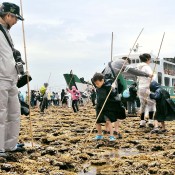
April 8, 2012 Ryukyu Shimpo
On April 7, a sightseeing tour began to put people on to the Yabiji coral reef during the spring tide in the sea north of Ikema Island, Miyako. Guided by two water carrier companies from Miyako, about 500 tourists enjoyed exploring Yabiji. These tours will run until April 8 and approximately 800 people are expected to set foot on Yabiji.
Yabiji, which is known as “a land of illusions,” is a huge coral reef that extends about 17 kilometers from north to south and about seven kilometers from east to west. Its total area below sea level would be one third that of Miyako Island.
Tidal conditions meant that the landing tour was scheduled for April 7 and 8.
Some people suggest that these tours bring a negative impact on the coral reef and the ecosystem. People walked carefully around trying not to step on the coral reef as a prefectural government employee requested that tourists not take any shells.
(English translation by T&CT, Megumi Chibana and Mark Ealey)
Go to Japanese
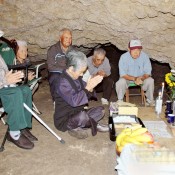
April 2, 2012 Ryukyu Shimpo
An incident of group suicide (shudan jiketsu), in which the Japanese military ordered or compelled 83 civilians to commit suicide occurred at Chibichiri Gama (a natural cave) in Namihira, Yomitan Village on April 2, 1945 soon after the U.S. forces landed on the main island during the Battle of Okinawa. On April 1, the Bereaved Families Association held a memorial service at the gama to mark the anniversary of this tragic incident. About 20 members of bereaved families gathered and prayed for the repose of the souls of those who died, pledging to strive to create peace.
After sweeping around the entrance of the gama, the family members made on offering of Okinawan food and placed a floral tribute inside the dimly lit cave. They then commemorated the deaths of the victims by offering incense sticks. Even though 67 years have passed since the end of World War II, and despite the scenery around the gama having changed during that time, it still exists as a horrible memory for the bereaved families, some of whom wept as they recalled the past.
Ninety-two year-old Kamado Chibana of Yomitan Village, who miraculously survived the war, lost her son, Giichi Chibana, who was four years old at the time, in the gama. Chibana quietly said, “I cannot forget my son; he was a lovely child. I really hope that he rests in peace.”
Norio Yonaha, a member of the Bereaved Families Association referred to the current trend not to describe the Imperial Japanese Army’s cruel treatment of the local citizens in the Battle of Okinawa in explanatory plates at battle sites or in textbooks, saying, “This perverts historical facts and reflects the recent trend toward militarism, which I find rather frightening. Some of the U.S. military bases in Okinawa have been involved in wars. I would like Chibichiri Gama to become a place to promote peace and prevent the sort of tragedy that happened here from being repeated.”
(English translation by T&CT, Mark Ealey)
Go to Japanese
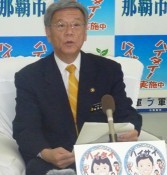
March 29, 2012 Ryukyu Shimpo
On March 28, Naha Mayor Onaga announced that the city’s Uchinaguchi greeting campaign will commence from next month. Office staff members welcome citizens visiting the municipal office in Uchinaguchi. Mayor Onaga said, “Uchinaguchi is the foundation of our culture, and we will promote it from our office. I want it to grow in Okinawa.”
Naha Municipal Office has developed an implementation plan to boost the campaign. In the plan, the office members are required to begin public speeches with haisai, which means hello and end the speech with nifedebiru, or thank you in Uchinaguchi. The plan also makes reference to schools’ role in raising awareness of the popularization of traditional culture.
Posters and logos created by staff, and a DVD featuring Mayor Onaga will be used for the campaign. The municipal office has also prepared a conversation book for staff members who are not well versed in Uchinaguchi, and with the help of companies that will cooperate in the endeavor plans to add an Uchinaguchi voice function to automatic machines that issue copies of family registers and to ATMs.
Mayor Onaga said, “Uchinaguchi is the foundation of Okinawan culture. We will do our best to promote the language, and I hope that we can provide tangible results.”
(English translation by T&CT, Shinako Oyakawa and Mark Ealey)
Go to Japanese
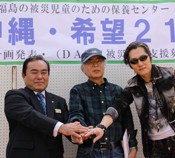
March 31, 2012 Yoko Morinaga, correspondent of the Ryukyu Shimpo
A project called Okinawa Hope 21 that aims to accept children from Fukushima into a recreation center in Kumejima is about to commence. On March 30, a press conference to announce the project was held at Yamashiro, Kumejima on the site planned for the center. Ryuichi Hirokawa, the editor in chief of Days Japan, a monthly news report magazine, who established the Chernobyl Children’s Fund Japan in 1991 and built a recreation facility in Belarus, is promoting the project.
Using land that previously used by a pottery factory, the recreation center will include dormitories, a dining and lecture hall, and a classroom for workshops. About 100 children from Fukushima will visit there a month in class units, and will be able to use the facilities for free. Once the renovation work is complete, the center will commence operation from June at the earliest.
At the press conference, Hirokawa said, “Kumejima has an atmosphere of safeness and calm. In future, I hope to run the facilities as a corporation in cooperation with local people.”
Tatsuya Ishii, a singer who supports the project, and Choko Taira, the mayor of Kumejima also attended to the press conference.
Ishii contributed 20 million yen to this project from donations gathered at his live music performances. “I hope that many people understand that the children in Fukushima have been at great risk. This is the most needed project in Japan. Breathing fresh air in a safe place, and seeing the beautiful blue of the ocean will lift the children’s spirits,” Ishii said.
Mayor Taira said, “We would like to support the children so they can go back home refreshed in mind and body.”
Hirokawa is asking for contributions to help run the facilities. For further details, call Days Japan at 03 (3322) 0233.
(English translation by T&CT, Lima Tokumori and Mark Ealey)
Go to Japanese












 Webcam(Kokusai Street)
Webcam(Kokusai Street)


